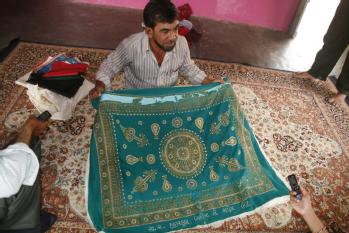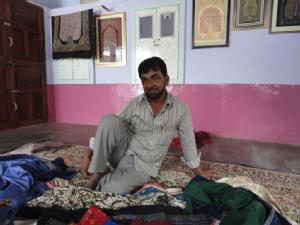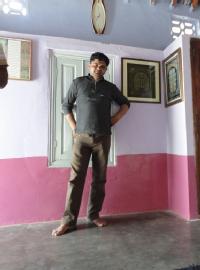Sumar Daud Khatri and Abdul Gafur Khatri
|
Age: 30 and 46 Occupation: rogan work Education: Class 5 and class 4 Residence: Nirona Date of Interview: 26/05/2012 Please see Abdul Gafur's website: http://traditionalroganart.com/ |
Gujarati Summary (Abdul): Download
|
Sumar |
Sumar Khatri
The rogan art form is not well-known beyond textile buyers and certain specialists. Rogan is now only produced in a few parts of Gujarat, one of which is the village of Nirona in Kachchh. Originating in medieval Persia, rogan work consists of extremely detailed and elegant painted or embossed fabric. Migration and cultural exchange introduced the art form to Kachchh around four hundred years ago. The rogan artists of Kachchh are also known as the Chapparas (those who imprint) although the word ‘rogan’ is derived from a Persian term for ‘oil-based’.
Sumar Khatri was the first rogan artisan we interviewed. He felt strongly that more support should be provided to ensure the stability of his art form, and expressed his wish for rogan to be more widely known. He told us that, around fifty to sixty years ago, rogan work was not particularly highly valued outside of certain communities. Ahir women wore rogan-painted ghagras (skirts) and odhanis, and the Muttwas also commissioned work from rogan artists. Such demand provided a limited income for Sumar’s forefathers, who could earn around five to six hundred Rupees for the work. Frustrated by this meagre value and limited demand, Sumar told us that his elder brother Abdul Gafur gave up the work and moved to Mumbai in search of a new livelihood. Back home, his grandfather continued the work. In 1984-85, Gafur honoured his grandfather’s call to return to finish an important order; at this time too, the government’s initiatives to support and encourage artisans provided much needed help. Gafur even won a state award for his rogan work in 1988. Sumar felt that his family’s craft thrived after this point and they went on to receive a range of national awards in the 1990s.
 Rogan is prepared by boiling safflower, linseed or castor oil over two days. During this process the oil is highly flammable and a dhakni (a clay lid) is used to suppress any flame. After cooling, the substance is thickened by mixing in colouring agents, derived from a variety of mineral and eco-friendly sources. The colour pastes – yellow, red, white, green, black and orange – are kept in earthen pots with water to keep them moist and to retain their malleability. The colour must also be kept free from other chemicals, and must be used within two to three weeks, or it will spoil.
Rogan is prepared by boiling safflower, linseed or castor oil over two days. During this process the oil is highly flammable and a dhakni (a clay lid) is used to suppress any flame. After cooling, the substance is thickened by mixing in colouring agents, derived from a variety of mineral and eco-friendly sources. The colour pastes – yellow, red, white, green, black and orange – are kept in earthen pots with water to keep them moist and to retain their malleability. The colour must also be kept free from other chemicals, and must be used within two to three weeks, or it will spoil.
Usually, the designs are drawn freehand, without any tracing, on a piece of cotton or silk. Artisans used their own artistic knowledge and imagination to create the vibrant designs and patterns. With the help of an iron rod, flat at both ends, a single line of oil pastel can re rubbed and stretched to form floral and spotted embossed patterns. These fine designs are extremely intricate and require intense patience and a steady hand. Perhaps the most prized design in the Tree of Life. Sumar connects it with the Hindu Kalpvruksh. The Tree of Life is adorned with exotic enamel or meenakari, and gold and silver colours added to create the beautiful finished design. A full design can take many months or years to complete. Once the painting is complete, the blank side of the fabric is pressed to create a mirror image. This has to be done with the utmost care to avoid damaging the design; even with great care, Sumar adds, mild smudging often occurs.
The roganists have been visited by tourists from sixty countries, including the USA, England, France, Italy, Israel, Switzerland and Germany. In recent years, more Indian buyers have emerged perhaps reflecting a growing domestic interest in the craft. Despite these developments, Sumar feels more can be done to publicise rogan, perhaps through the BDOs (Block Division Officers) of Kachchh, regional officials and even NGOs. Some initiatives, such as the Gujarat state promoted tourism through the annual Rann festival has little benefit as tourists often attend the festivities and often leave without seeing the rogan artisans’ work. Nevertheless, Sumar felt strongly that foreign finance can be helpful, and recently participated in a tourism promotion advertisement with the India film icon Amitabh Bachan. For Sumar, the key issue is that there seems to be a general lack of awareness about the technique and creation of rogan pieces; the art continues to be thought of as simply a printed or embroidered piece of fabric.
Sumar’s nephew Sahil (Gafur’s son) has just joined the family business; the eighth generation of the family that has pursued this rare art form.
Abdul Gafur Khatri
 Gafur described how the family continually try and elevate the standard of their medieval art form. For him, the art is fundamentally varsagat (hereditary) and he learnt by watching his father and grandfather. The family have worked hard to preserve their skills and have retained several examples of their work. One important piece is a bedspread-sized, hand-woven cotton silk called daniyu that is over fifty years old. All of the rogan work is embossed onto cloth which is later made into a range of other products; cushion covers are a particularly common item requested by foreign clients. Gafur and his family have acquired a working knowledge of English to communicate with the many tourists that come to view and purchase their work.
Gafur described how the family continually try and elevate the standard of their medieval art form. For him, the art is fundamentally varsagat (hereditary) and he learnt by watching his father and grandfather. The family have worked hard to preserve their skills and have retained several examples of their work. One important piece is a bedspread-sized, hand-woven cotton silk called daniyu that is over fifty years old. All of the rogan work is embossed onto cloth which is later made into a range of other products; cushion covers are a particularly common item requested by foreign clients. Gafur and his family have acquired a working knowledge of English to communicate with the many tourists that come to view and purchase their work.
Gafur told us that the family developed their mastery over the work in the 1980s. Before that they made the rough work Sumar termed ‘folk art’ that lacked intricate designs and was reserved only for the Maldharis. It was crudely done through imprecise strokes and uneven lines. Gafur is an ambitious man, and described his many arman (dreams) that he aspires to complete through his work. He has developed several innovative product lines including designing costly saris with rogan work, simple folders, mobile phone covers, bags, and duppats, to make it affordable to a wider range of customers. He claims that before him, no one made rogan saris. Working with silk needs particularly high levels of skill and concentration and a silk sari with rogan work can command a price of up to twenty-five thousand Rupees.
Gafur’s family suffered some difficult times in the past. Their regular customers the Maldharis turned to synthetic wear and found rogan comparatively expensive. This greatly affected the income of Gafur’s family and there were occasions when they were forced to go without any money for an extended period, having no other means of earning beyond their art. Having lived through such difficult situations, Gafur is content with the family’s present situation. He is a well-travelled man, and has visited Delhi, Mumbai, Pune and Calcutta to exhibit his products. International recognition has also eased Gafur’s hunger for dhad (appreciation) and has boosted his enthusiasm for his art. His workshop is adorned with photographs of him and his brothers receiving national and state honours (five national awards and four state awards). Gafur’s mastery of in embossing the Tree of Life design in particular has won him many customers and awards. He has played an instrumental role in reviving the family art form and encouraging his siblings to join the business: Gafur, Sumar, Juma, Asraf, Gafur’s uncle and his sons, and Gafur’s son form the family’s team of eight who are engaged in rogan work.
The women in the family work with bandhani. Gafur told us that his ancestors were reluctant to pass on rogan skills to women in the family, fearing knowledge of the art may be passed on to other families through marriage. For this reluctance to spread the knowledge of the craft, previous generations of the family were frowned upon by society. By contrast, Gafur has a proud record of teaching and passing on rogan skills to girls. With the help of a Paris-based NGO, Gafur trained sixty Hindu and Muslim girls, although the organisation unfortunately closed two years ago. Despite this, he is now working with the government to train a new cohort. Although rogan kaam (work) is now taught to many girls, not all succeed. Some lose interest, while the distance between Bhuj and Nirona is also a factor. Those who follow the art are, however, earning well and are paid on a per article basis.
Gafur and his family have now moved to making popular garments with rogan elements, and they intend to launch designer kurtis and jackets ranging from 1000 to 4000 rupees. They have also introduced a range of cheaper products including mobile phone covers (fifty rupees), folders (300) and ladies bags (300), responding to the requests of both locals and visitors. The roganists receive many visitors in the summer months and are constantly engaged in work from August or September onwards. The family now understands the fact that they receive many international visitors because of the beauty of their art, which makes them extremely proud. Gafur told us that despite offers from Jaipur to display their work and receive more orders, he feels the family are better off in Kachchh as it provides them with standing and identity in the community. He does not regret the struggles of his family in previous years as the constant battle to succeed and drive forward has pushed them to develop the business

